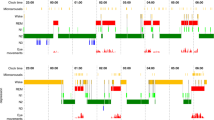Summary
Preliminary results are presented from an ongoing study in hospitalised depressed patients. Changes in sleep parameters were assessed on days 1 to 3 and 12 to 14 of a 4-week study in which patients received trimipramine 150mg on day 1 and 100mg thereafter. On days 1 to 3 and 12 to 14, 7 depressed patients had a significantly increased total sleep time and sleep efficiency index and a significantly decreased total wake time and number of intrasleep wake episodes per hour of sleep. Trimipramine treatment had no significant effect on REM sleep, percentage of REM sleep, REM duration and REM sleep stability index. However, a significant increase in REM latency was noted on days 1 to 3 but not on days 12 to 14. These polygraphic data suggest that trimipramine effects a very rapid and maintained sleep improvement in these depressed patients without significant alterations to the parameters of REM sleep.
Similar content being viewed by others
Reference
Rechtschaffen A, Kales A (Eds). A manual of standardized terminology, techniques and scoring system for sleep stages of human subjects, Public Health Service Publications no. 204, US Government Printing Office, Washington, 1968
Author information
Authors and Affiliations
Rights and permissions
About this article
Cite this article
Mouret, J., Lemoine, P., Minuit, MP. et al. Sleep Polygraphic Effects of Trimipramine in Depressed Patients Preliminary Report. Drugs 38 (Suppl 1), 14–16 (1989). https://doi.org/10.2165/00003495-198900381-00005
Published:
Issue Date:
DOI: https://doi.org/10.2165/00003495-198900381-00005




